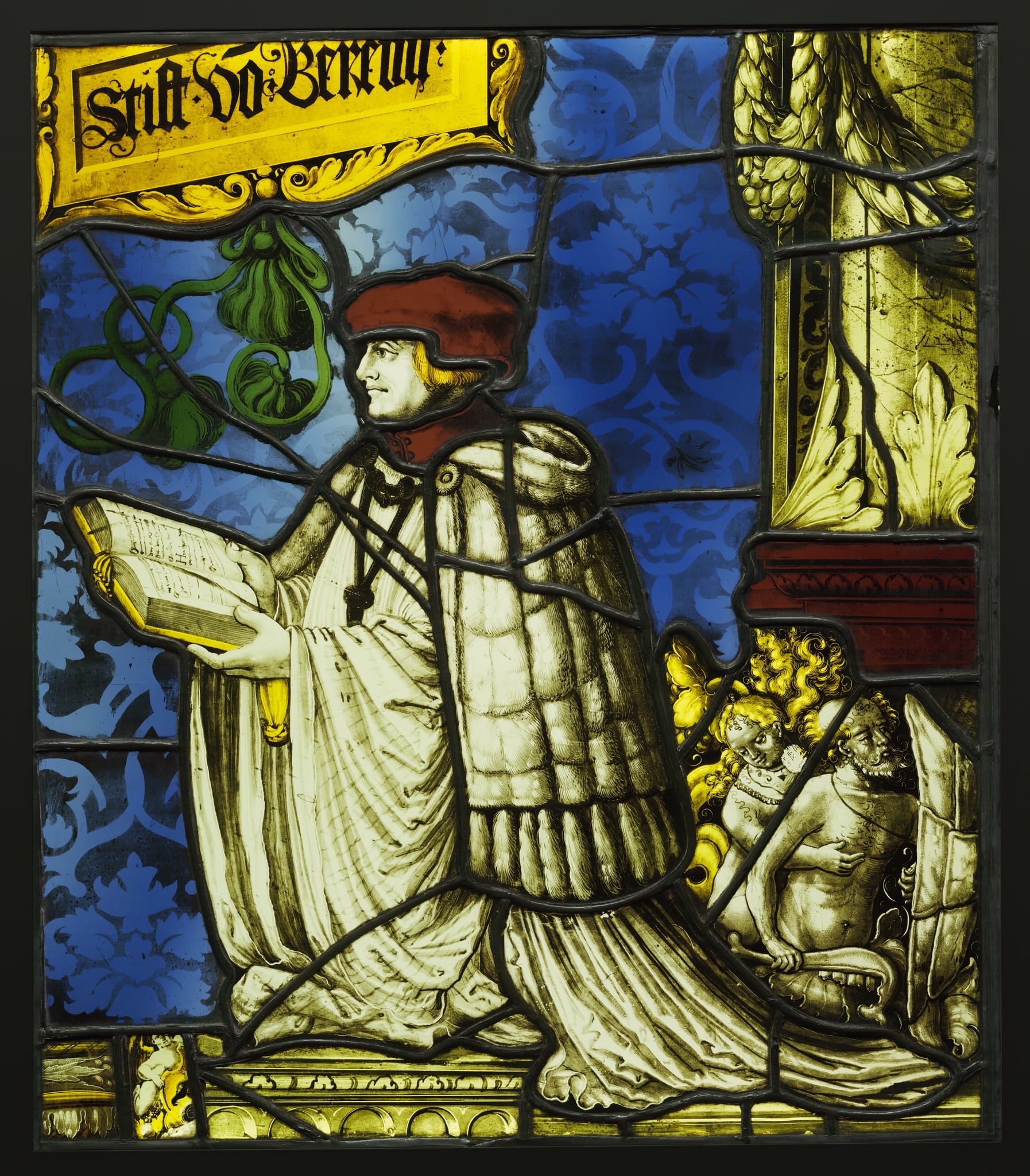The panel was at the Frankfurt am Main auction of Hugo Helbing in 1932 (Helbing, 1932, nr. 208) identified as Freiburg or Basel, about 1520. In 1933, it was offered to the Historic Museum of Berne, by A. Klein, Frankfurt but is then not documented until its appearance in the Sam Fogg catalogue of 2002. In the catalogue, the panel was attributed to a site identified as the Premonstratensian Abbey of Rot an der Rot, Berkheim (Michael, 2002, pp. 7, 94–99, 122, no. 42). The attribution was continued by Raguin (Raguin, 2024, vol. 2, pp. 157–160), a conclusion now viewed as problematic. A closer look at the inscription suggests a more probable location as Bern, which was often written “Bernn,” although only rarely “Berenn.” However, in reviewing the names of collegiate foundations in the Swiss Confederation, the Vinzenzenstift of Bern is the clear choice. The canon’s red biretta might identify him as dean. In 1528, Bern adopted Reformed religious practices and imagery for churches was no longer supported. This image of a canon may then have been relocated. It may also have been a donation by the Vinzenzenstift to another site.
The canon adopts a standard pose for portraits of individuals in a religious context at the time; the soft cap was worn by clergy and scholars. The presentation speaks to his power and success. Michael (2002, pp. 94–99, 122, no. 42) suggests a climate of Renaissance humanism animating the panel. The book is written in a Renaissance hand, not the Gothic lettering of the inscription. The architectural framing and the sea god who carries a tortoise-shell shield and holds a jawbone as a weapon further attests to a new sensibility. Albrecht Dürer’s engraving, The Sea Monster (ca. 1498, Metropolitan Museum of Art 19.73.80), like the panel, shows a woman riding on the back of monster composed of a scaly body and male human torso.
An association with Hans Holbein the Younger seems probable. Holbein was born in Augsburg into a family of artists. Seeking a broader patronage base, he and his brother Ambrosius moved to Basel about 1514 or 1515. The artist’s reputation reached a level of international acclaim by the early 1520s. These years of crisis in Switzerland’s religious reforms, however, were not supportive to the arts and Holbein left Basel for London, although he did return to Switzerland for several years.
Holbein was immensely influential for the development of glass panting in Switzerland. Some of Holbein’s own panels survive, most notably a panel of the sainted Emperor Henry II with the arms of Basel from the cloister of the Cistercian Abbey of Wettingen of 1522 (West IVb; Hoegger, 2002, pp. 33–36, 121, 312–14; Schmidt, & Reinhardt, 1960, p. 181, no. 151, fig. 59). The artist’s bold concepts of monumental composition and ability to fuse late-medieval surface design with Renaissance three-dimensional space made him, like Albrecht Dürer, a key figure in the transformation of northern artistic thinking (Ganz, 1903, pp. 197–207; Ganz, 1937). The heavy column with its leafy swags stands out in the Getty panel. A wash drawing by Holbein showing the Ecce Homo, about 1528, part of a series of ten designs for stained glass depicting the Passion of Christ, displays similar composite columns with three- dimensional acanthus leaves (Kunstmuseum, Basel; Butts, & Hendrix, 2000, pp. 304–309, nos. 146–50). Details such as the soft cap, prominent nose and soft jowl link the panel to Holbein’s drawing, Portrait of a Scholar or Cleric, about 1532–1535 (J. Paul Getty Museum 84.GG.93). Both figures seem caught in moment of peaceful refection, yet personality is still visible through delicate treatment of features. Even when executed by the hand of the anonymous glass painter, the panel evokes Holbein’s fusion of Italianate volumetric presence and northern tactile sensibilities. Note, in particular, the detail of the canon’s furry cape, the almuce that was worn as a choir vestment. A date of about 1520 is based on the artist’s work in Basel at the time. The Premonstratensian abbey church of Rot was rebuilt by 1509 but gifts of leaded and painted windows often came considerably after the architecture.
The workshop responsible for producing windows for Vinzenzenstift of Bern, may very well have acquired material from several designers, as we know to be the case for other series of Swiss windows. Urs Graf, an engraver, painter, and woodcut and stained glass designer was active in Basel at the same time as Holbein. Michael associated the sea gods with Andrea Mantegna’s print (before 1481, Chatsworth, Devonshire collection, Chatsworth House, Album I, n. 38; National Gallery of Art, Washington DC, 1984.53.1), which was well known in Northern Europe. Urs Graf made a pen and ink copy of the drawing (Basel, Öffentliche Kunstsammlung, U.IV. 57). The lively depiction of the sea monster carrying a woman evokes the vitality and expressiveness of Graf’s many drawings. Michael (2002, p. 99) illustrated Graf’s drawing of a naked woman playing the viol in front of an Old Fool, dated 1523 (Darmstadt Hessisches Landesmuseum), showing a similar tilted head and wildly flowing corkscrew curls.
Cited in:
Helbing, 1932, nr. 208, p. 18, illustrated on title page.
Michael, 2002, pp. 7, 94–99, 122, no. 42.
Getty Museum Handbook, 2007, p. 192.
Getty Collections, 2009, p. 57.
Raguin, 2013, pp. 54, 66–69, fig. 45.
Raguin, 2024, vol. 1, pp. 19, 22–21, 26, vol. 2, pp. 157–160.
c. 1520
